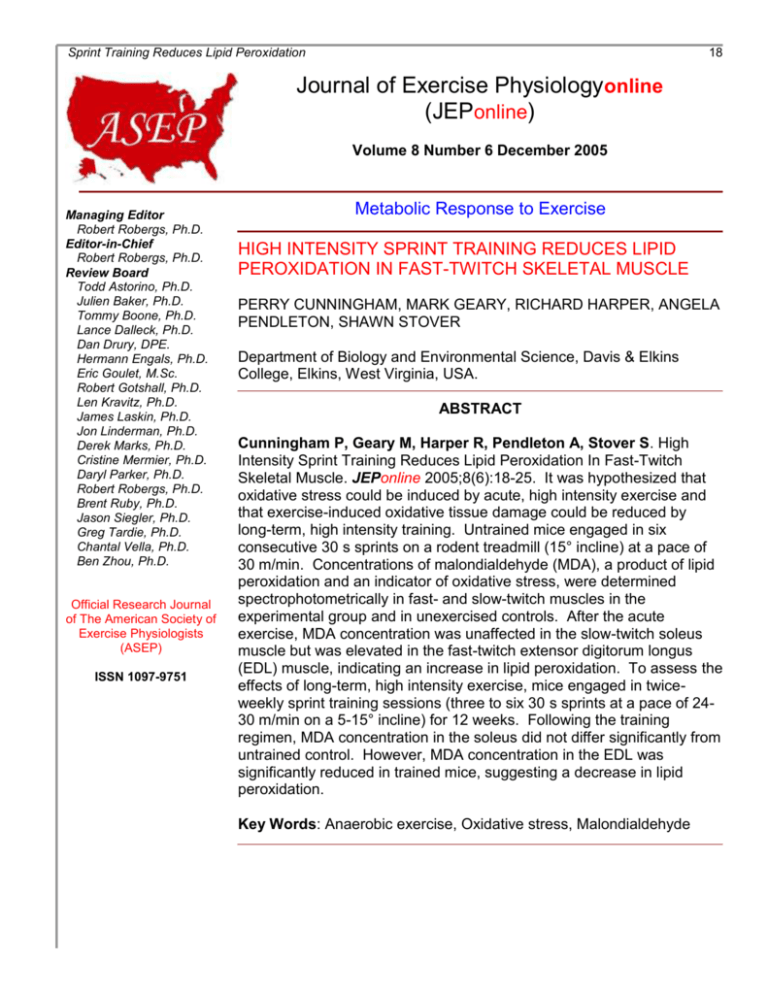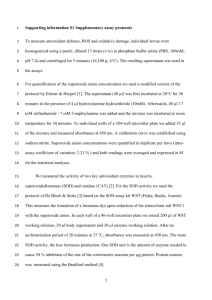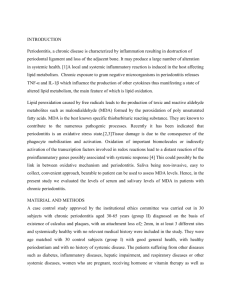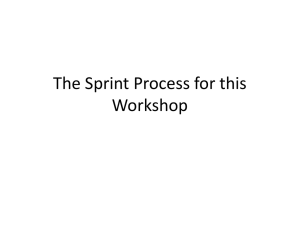1 Sprint Training Reduces Lipid Peroxidation Metabolic Response
advertisement

Sprint Training Reduces Lipid Peroxidation 18 Journal of Exercise Physiologyonline (JEPonline) Volume 8 Number 6 December 2005 Managing Editor Robert Robergs, Ph.D. Editor-in-Chief Robert Robergs, Ph.D. Review Board Todd Astorino, Ph.D. Julien Baker, Ph.D. Tommy Boone, Ph.D. Lance Dalleck, Ph.D. Dan Drury, DPE. Hermann Engals, Ph.D. Eric Goulet, M.Sc. Robert Gotshall, Ph.D. Len Kravitz, Ph.D. James Laskin, Ph.D. Jon Linderman, Ph.D. Derek Marks, Ph.D. Cristine Mermier, Ph.D. Daryl Parker, Ph.D. Robert Robergs, Ph.D. Brent Ruby, Ph.D. Jason Siegler, Ph.D. Greg Tardie, Ph.D. Chantal Vella, Ph.D. Ben Zhou, Ph.D. Official Research Journal of The American Society of Exercise Physiologists (ASEP) ISSN 1097-9751 Metabolic Response to Exercise HIGH INTENSITY SPRINT TRAINING REDUCES LIPID PEROXIDATION IN FAST-TWITCH SKELETAL MUSCLE PERRY CUNNINGHAM, MARK GEARY, RICHARD HARPER, ANGELA PENDLETON, SHAWN STOVER Department of Biology and Environmental Science, Davis & Elkins College, Elkins, West Virginia, USA. ABSTRACT Cunningham P, Geary M, Harper R, Pendleton A, Stover S. High Intensity Sprint Training Reduces Lipid Peroxidation In Fast-Twitch Skeletal Muscle. JEPonline 2005;8(6):18-25. It was hypothesized that oxidative stress could be induced by acute, high intensity exercise and that exercise-induced oxidative tissue damage could be reduced by long-term, high intensity training. Untrained mice engaged in six consecutive 30 s sprints on a rodent treadmill (15° incline) at a pace of 30 m/min. Concentrations of malondialdehyde (MDA), a product of lipid peroxidation and an indicator of oxidative stress, were determined spectrophotometrically in fast- and slow-twitch muscles in the experimental group and in unexercised controls. After the acute exercise, MDA concentration was unaffected in the slow-twitch soleus muscle but was elevated in the fast-twitch extensor digitorum longus (EDL) muscle, indicating an increase in lipid peroxidation. To assess the effects of long-term, high intensity exercise, mice engaged in twiceweekly sprint training sessions (three to six 30 s sprints at a pace of 2430 m/min on a 5-15° incline) for 12 weeks. Following the training regimen, MDA concentration in the soleus did not differ significantly from untrained control. However, MDA concentration in the EDL was significantly reduced in trained mice, suggesting a decrease in lipid peroxidation. Key Words: Anaerobic exercise, Oxidative stress, Malondialdehyde Sprint Training Reduces Lipid Peroxidation 19 INTRODUCTION Generation of reactive species such as singlet oxygen, superoxide radical, and hydroxyl radical occurs as a consequence of normal cellular metabolism (1). Reactive oxygen-related damage includes DNA strand breaks and single base modifications (2), oxidation of amino acid side chains and fragmentation of polypeptides (3), and the degradation of polyunsaturated fatty acids and phospholipids by lipid peroxidation (4). Processing of reactive oxygen is carried out by the body’s endogenous antioxidant defense system, which includes enzymatic activity of superoxide dismutase (SOD), glutathione peroxidase (GPx), and glutathione reductase (GR), in conjunction with exogenous antioxidants consumed through diet (1). Oxidative stress may be defined as a condition in which the cellular production of reactive oxygen exceeds the body’s physiological capacity to render reactive species inactive (4). Reactive oxygen species have very short half-lives, ranging from 2 to 20 s for singlet oxygen (5), approximately 30 ms for the superoxide radical (6), and 10-9 s for the hydroxyl radical (7). However, it has been estimated that reactive species form at a rate of about 1011 per cell per day. Consequently, aerobic organisms are always subject to oxidative stress (8). Furthermore, reactive species may initiate chain reactions of oxidation. For example, the hydroxyl radical will react by either binding to or abstracting hydrogen from target molecules. In either case, new reactive species are formed. Such a chain reaction can lead to lipid peroxidation. Reactive oxygen species target the carbon-carbon double bonds of the polyunsaturated fatty acids abundant in cellular membranes. The double bond on the carbon makes the carbon-hydrogen bond relatively weak, allowing hydrogen to be easily dissociated by a reactive species. Removal of the hydrogen leaves the carbon with an unpaired electron, creating a new reactive species (2). The rapid peroxidation of lipids disrupts membrane organization, affecting fluidity and permeability (9), and may be a source of cytotoxic aldehydes (10). The increase in oxygen uptake during aerobic exercise is accompanied by an elevation of reactive oxygen species. Acute aerobic exercise generates reactive oxygen by creating a disturbance in electron transport that leads to excessive leakage of superoxide radicals (4). However, long-term endurance training effectively reduces the damage associated with increased oxygen uptake by enhancing the body’s antioxidant defenses. It has been demonstrated that GPx (11), GR (11), and SOD (12) activities increase in response to endurance training. Acute anaerobic exercise can promote increased oxidation of lipids. In rats, a single one-minute sprint at 45 m/min elevates lipid hydroperoxides and thiobarbituric acid reactive substances (TBARS) in skeletal muscle, indicating significant lipid peroxidation (13). In mice, 15 30 s sprints at a pace of 35 m/min significantly increase TBARS in skeletal muscle and liver (14). In humans, six 150 m sprints (15), or one submaximal resistance exercise circuit (16), increase plasma levels of the lipid peroxidation marker, malondialdehyde (MDA). While responses to endurance training have been relatively well documented, the effects of training methods that emphasize the use of fast-twitch glycolytic muscles have not received as much attention. Previous studies indicate that activity of GPx and GR increases significantly following sprint training (17) and that regular resistance training may aid in the prevention of lipid peroxidation during exercise (16). The present study investigated the hypotheses that 1) oxidative stress can be induced by acute, high intensity exercise, and 2) exercise-induced oxidative tissue damage can be reduced by long-term, high intensity training. If acute, high intensity exercise can induce lipid peroxidation in fasttwitch skeletal muscle, then elevated levels of MDA should be evident in the extensor digitorum longus (EDL) following a single bout of high intensity sprinting. Furthermore, if high intensity training Sprint Training Reduces Lipid Peroxidation 20 can reduce the deleterious effects of oxidative stress, then MDA concentration should be reduced in the EDL following long-term, high intensity sprint training. METHODS Animals The Institutional Animal Care and Use Committee of Davis & Elkins College approved this study. Thirty male albino ICR (CD-1®) mice (Harlan, Indianapolis, IN), 5-7 weeks old when training was initiated, were housed one to two per cage in a room maintained at 18-24°C with 12:12 light-dark cycles. All mice had free access to water and food (Fortified Diet for Rats and Mice, Kaytee Products, Inc., Chilton, WI). Acute Exercise Untrained experimental mice (n=8) engaged in six consecutive 30 s sprints on a rodent treadmill at a pace of 30 m/min (15° incline), with a 1 min recovery interval between each sprint. Control mice (n=5) did not exercise. An electrified grid (0.2 mA) at the rear of the treadmill was used sparingly as motivation to run. All exercise procedures were carried out between 9:00 a.m. and 12:00 p.m. Exercise Training Table 1. The mouse training schedule. Experimental mice (n=9) participated in a high intensity Training Number of Speed Incline (°) training program consisting of treadmill running two days Week Sprints (m/min) a week for 12 weeks. Each session included three to six 1-3 3 24 5 30 s sprints at a pace of 24-30 m/min (5-15° incline; 4 4 24 5 Table 1), with a 1 min recovery interval between each 5-6 4 27 10 sprint. Control mice (n=8) were not involved in the 7-8 5 27 10 training process. At the end of the training period, 9 5 30 15 trained and untrained mice engaged in six consecutive 10-12 6 30 15 30 s sprints on a rodent treadmill at a pace of 30 m/min (15° incline), with a 1 min recovery interval between each sprint. An electrified grid (0.2 mA) at the rear of treadmill was used sparingly as motivation to run. All exercise procedures were carried out between 9:00 a.m. and 12:00 p.m. Assessment of Lipid Peroxidation Mice were sacrificed by cervical dislocation. Sacrifice of exercised animals was carried out immediately after the final 1 min recovery interval. Soleus and EDL muscles were extracted from hind limbs, rinsed with cold distilled water, homogenized in 20 mM Tris-HCl buffer (pH 7.4), and reacted with N-methyl-2-phenylindole (R1) at 45°C. R1 combines with MDA to generate a stable chromophore with maximal absorbance at 586 nm (Colorimetric Assay for Lipid Peroxidation, Oxford Biomedical Research, Oxford, MI). To account for background absorbance, matched negative controls containing Tris-HCl buffer in place of tissue homogenate were prepared. Experimental samples and controls were analyzed spectrophotometrically at 586 nm. MDA concentrations were calculated from the absorbance values using the following formula: [MDA] = ([A 586 – b]/a) x df, where [MDA] is the M concentration of MDA in the sample, A586 is the net absorbance of the sample at 586 nm, a is the slope of the MDA standard curve (MDA standards were included in the assay kit), b is the intercept of the standard curve, and df is the dilution factor of the sample. Statistical Analyses A one-way analysis of variance (ANOVA) was used to determine variability between group means. Two-sample t tests were used to compare specific groups in the one-way ANOVA. All t tests were two-tailed, and an alpha level of p<0.05 was regarded as statistically significant. Data are expressed as mean ± standard deviation. Sprint Training Reduces Lipid Peroxidation 21 RESULTS Acute Exercise Following acute exercise, MDA concentration in the slow-twitch soleus did not differ significantly from unexercised control. However, acute exercise resulted in significant elevation of MDA concentration in the fast-twitch EDL (17.276 ± 1.86 M), relative to unexercised control (11.638 ± 3.16 M; Figure 1). 20 18 16 * MDA ( M) 14 12 10 No Exercise Acute Exercise 8 6 4 2 0 Soleus EDL Tris Buffer Figure 1. Results of the acute effect of exercise. Values represent mean ± standard deviation; *Significantly different from “Acute Exercise” (p<0.05); Samples containing only the homogenization buffer were analyzed to control for nonspecific absorbance. Exercise Training Following the training regimen, MDA concentration in the soleus did not differ significantly from untrained control. However, MDA concentration in the EDL was significantly reduced in trained mice (14.257 ± 4.12 M), relative to untrained control (17.641 ± 1.60 M; Figure 2). 20 * 18 16 MDA ( M) 14 12 10 Acute exercise Post-training 8 6 4 2 0 Soleus EDL Tris buffer Figure 2. Results of the training effect of exercise. Values represent mean ± standard deviation; *Significantly different from “Acute Exercise” (p<0.05); Samples containing only the homogenization buffer were analyzed to control for nonspecific absorbance. Sprint Training Reduces Lipid Peroxidation 22 DISCUSSION The extent of oxidative tissue damage depends on the balance between generated oxygen radicals and antioxidant defenses of the tissue. SOD breaks down the superoxide radical to form hydrogen peroxide (H2O2). Subsequently, H2O2 is converted to water by either peroxisomal catalase (CAT) or cytoplasmic GPx (18). Reduced glutathione (GSH) plays a prominent role in the cellular defense against oxidative stress by scavenging reactive oxygen species, both directly and as a substrate for GPx (19). Conversion of GSH to GSSG, the oxidized form of the molecule, is catalyzed by GPx during the reductive detoxification of H2O2 (20). GSH is regenerated from GSSG by activity of GR (21). Although some epithelial cells have the capacity to take up intact GSH (22), most cells rely on de novo synthesis to maintain cellular stores. GSH is synthesized by a two-step process involving the enzymes, -glutamate-cysteine ligase (GCL) and glutathione synthetase (GS). GCL catalyzes the intracellular reaction that results in attachment of a sulfhydryl-containing cysteine residue to a glutamate residue. Activity of GS adds a glycine residue to complete the tripeptide (19). Normally, reactive oxygen is broken down rapidly by defensive mechanisms. Toxic effects of oxidative stress are only observed when the rate of reactive oxygen formation exceeds the rate of inactivation. It is widely accepted that the increase in reactive oxygen associated with aerobic exercise is largely due to an increase in mitochondrial electron transport and the subsequent leakage of superoxide radicals (4). However, the mechanism by which acute anaerobic exercise leads to oxidative stress remains unclear. It has been suggested that the increase in reactive oxygen produced by resistance exercise may be the result of mechanical injury to muscle fibers, leading to proteolysis, inflammation, and an imbalance in calcium homeostasis (4,23). Furthermore, it has been demonstrated that glycolytic power peaks very early during high intensity exercise and is followed by significant mitochondrial ATP synthesis (24,25). In addition to the contribution of aerobic metabolism, and the subsequent disturbance in electron transport, the elevation in reactive oxygen generated by sprint exercise may also be affected by ischemia/reperfusion. The sudden uptake of oxygen following a sprint may react with accumulated metabolic intermediates to generate elevated levels of oxygen radicals (4,23). Results of the present study suggest a beneficial effect of high intensity sprint training. Lipid peroxidation, as indicated by MDA concentration, is significantly decreased in the fast-twitch EDL after 12 weeks of training. The mechanism behind the peroxidation reduction is unclear. An upregulation of GPx activity may be responsible. Because of its sensitivity to intracellular levels of reactive oxygen and its role in the destruction of the end products of oxidation (including lipid peroxides), GPx may be the most important antioxidant enzyme for cell survival (26). An increase in GSH may also contribute to the training adaptation in the present study. Endurance training has been shown to increase GSH content in hind limb muscles of dogs (27) and rats (12). High intensity sprint training may produce a similar effect. Of course, an increase in GSH may reflect an increase in the activity of GCL, the rate-limiting enzyme in GSH synthesis. Finally, it is possible that the beneficial effect is due to an increased capacity for oxidative phosphorylation. Previous studies have confirmed increased mitochondrial mass in response to conditions of oxidative stress (28,29). Each of these mechanisms must be studied further. The aging process leads to an increased production of reactive oxygen by mitochondria that become progressively less efficient at transporting electrons within cells that become progressively less efficient at expressing antioxidant enzymes (30,31). Consequently, oxidative stress is implicated in many physiological disorders associated with aging. For example, oxidation of low-density lipoprotein (LDL) in blood vessels is now considered a primary factor in the development of atherosclerosis (32), and the brains of patients with Alzheimer’s disease exhibit elevated concentrations of MDA and a Sprint Training Reduces Lipid Peroxidation 23 decrease in CAT activity (33). Endurance-trained muscles have higher levels of antioxidant enzyme activity and GSH content, allowing more efficient removal of reactive oxygen species (11,12,27). Consequently, endurance training reduces the impact of age-related oxidative stress. Following an endurance training regimen, soleus muscles from aged rats express decreased concentrations of MDA, relative to sedentary controls (34). Sprint training may also provide protection against agerelated oxidative tissue damage. However, further study is required to determine whether the beneficial effects are limited to fast-twitch muscle. CONCLUSIONS In summary, results of the present study are consistent with previous work that demonstrates an increase in lipid peroxidation in response to acute, high intensity exercise (13,14,15,16). Furthermore, results indicate that long-term, high intensity training can effectively reduce the impact of oxidative stress by preventing excessive lipid peroxidation. In terms of human health, the benefits of endurance training are well known, but the positive impact of high intensity anaerobic training may be underrated. For example, Burgomaster et al. (35) recently demonstrated that intense sprint interval training can increase muscle oxidative potential and actually double endurance capacity. Results of the present study indicate that, in addition to its potency as a performance enhancer, high intensity sprint training may also provide a time efficient mechanism to diminish or reduce the effects of oxidative stress. Address for correspondence: Shawn Stover, Ph.D., Department of Biology and Environmental Science, Davis & Elkins College, 100 Campus Drive, Elkins, WV 26241. Phone: (304) 637-1275; Email: stovers@davisandelkins.edu. REFERENCES 1. Sen CK, Packer L, Hanninen O, editors. Exercise and Oxygen Toxicity. Amsterdam: Elsevier Science, 1994. 2. Halliwell B, Guttheridge JMC. Free Radicals in Biology and Medicine (2nd edition). New York: Clarendon Press, Oxford University Press, 1989. 3. Levine RL, Stadtman ER. Oxidative modification of proteins during aging. Exp Gerentol 2001;36: 1495-1502. 4. Bloomer RJ, Goldfarb AH. Anaerobic exercise and oxidative stress – a review. Can J Appl Physiol 2004;29(3):245-263. 5. Kearns D. Solvent and solvent isotope effects on the lifetime of singlet oxygen. In: Wasserman HH, Murray RW, editors. Singlet Oxygen. New York: Academic Press, 1979:115-137. 6. Sawyer D. Oxygen Chemistry. New York: Oxford University Press, 1991. 7. Sies H. Strategies of antioxidant defense. Eur J Biochem 1993;215:213-219. 8. Fridovich I, Freeman B. Antioxidant defenses in the lung. Ann Rev Physiol 1986;48:693-702. 9. Grinna L. Age-related changes in the lipids of the microsomal and mitochondrial membranes of rat liver and kidney. Mech Age Dev 1977;6:197-205. 10. Esterbauer H, Schau R, Zollner H. Chemistry and biochemistry of 4-hydroxynonenal, malondialdehyde and related aldehydes. Free Radic Biol Med 1991;11:81-128. 11. Venditt P, Di Meo S. Effect of training on antioxidant capacity, tissue damage, and endurance of adult male rats. Int J Sports Med 1997;18:497-502. Sprint Training Reduces Lipid Peroxidation 24 12. Leeuwenburgh C, Hollander J, Leichtweis S, Fiebig R, Gore M, Ji LL. Adaptations of glutathione antioxidant system to endurance training are tissue and muscle fiber specific. Am J Physiol 1997;272: R363-R369. 13. Alessio HM, Goldfarb AH, Cutler RG. MDA content increases in fast- and slow-twitch skeletal muscle with intensity of exercise in a rat. Am J Physiol 1988;255:C874-C877. 14. Kayatekin BM, Gonenc S, Acikgoz O, Uysal N, Dayi A. Effects of sprint exercise on oxidative stress in skeletal muscle and liver. Eur J Appl Physiol 2002;87:141-144. 15. Marzatico F, Pansarasa O, Bertorelli L, Somenzini L, Della Valle G. Blood free radical antioxidant enzymes and lipid peroxides following long-distance and lactacidemic performances in highly trained aerobic and sprint athletes. J Sports Med Phys Fitness 1997;37:235-239. 16. Ramel A, Wagner K, Elmadfa I. Plasma antioxidants and lipid oxidation after submaximal resistance exercise in men. Eur J Nutr 2004;43(1):2-6. 17. Atalay M, Seene T, Hanninen O, Sen CK. Skeletal muscle and heart antioxidant defenses in response to sprint training. Acta Physiol Scanda 1996;158:129-134. 18. Ramos KS, Chacon E, Acosta D. Toxic responses of the heart and vascular systems. In: Klaasen CD, editor. Casarett and Doull’s Toxicology: The Basic Science of Poisons. New York: McGrawHill, 1996:492-493. 19. Griffith OW. Biologic and pharmacologic regulation of mammalian glutathione synthesis. Free Radic Biol Med 1999;27:922-935. 20. Meister A. Selective modification of glutathione metabolism. Science 1983;220: 472-477. 21. Schultz GE, Schirmer RH, Sachsenheimer W, Pai EF. The structure of the flavoenzyme glutathione reductase. Nature 1978;273:120-124. 22. Hagen TM, Aw TY, Jones DP. Glutathione uptake and protection against oxidative injury in isolated kidney cells. Kidney Int 1988;34:74-81. 23. Jackson MJ. Exercise and oxygen radical production by muscle. In: Sen CK, Packer L, Hanninen O, editors. Handbook of Oxidants and Antioxidants in Exercise. Amsterdam: Elsevier Science, 2000:57-68. 24. Smith JC, Hill DW. Contribution of energy systems during a Wingate power test. Br J Sports Med 1991; 25(4):196-199. 25. Nioka S, Moser D, Lech G, Evengelisti M, Verde T, Chance B, Kuno S. Muscle deoxygenation in aerobic and anaerobic exercise. Adv Exp Med Biol 1998;454:63-70. 26. Remacle J, Lambert D, Raes M, Pigeolet E, Michiels C, Toussaint O. Importance of various antioxidant enzymes for cell stability. Biochem J 1992;286:41-46. 27. Kretzschmar M, Muller D. Aging, training, and exercise: a review of effects of plasma glutathione and lipid peroxidation. Sports Med 1993;15:196-209. 28. Lee H, Yin P, Lu C, Chi C, Wei Y. Increase of mitochondria and mitochondrial DNA in response to oxidative stress in human cells. Biochem J 2000;348:425-432. 29. Lee H, Yin P, Chi C, Wei Y. Increase in mitochondrial mass in human fibroblasts under oxidative stress and during replicative cell senescence. J Biomed Sci 2002;9(6):517-526. 30. Orr WC, Sohal RS. Extension of life-span by overexpression of superoxide dismutase and catalase in Drosophila melanogaster. Science 1994;263:1128-1139. 31. Ames BN, Shigenaga MK, Hagen TM. Oxidants, antioxidants, and degenerative diseases of aging. Proc Nat Acad Sci USA 1993;90:7915-7922. 32. McCance KL, Heuther SE. Pathophysiology (4th edition). St. Louis: Mosby, 2002. 33. Volicer L, Crino PB. Involvement of free radicals in dementia of the Alzheimer type: a hypothesis. Neurobiol Aging 1990;11:567-574. 34. Leewenburgh CR, Fiebig R, Chandwaney R, Ji LL. Aging and exercise training in skeletal muscle: response of glutathione and antioxidant enzyme systems. Am J Physiol 1994;267:R439-R445. Sprint Training Reduces Lipid Peroxidation 25 35. Burgomaster KA, Hughes SC, Heigenhauser GJF, Bradwell SN, Gibala MJ. Six sessions of sprint interval training increases muscle oxidative potential and cycle endurance capacity in humans. J Appl Physiol 2005;98:1985-1990.





